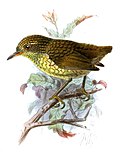Gavicalis
In the Gavicalis world there are an infinite number of aspects to discover and explore. From its origins to its current evolution and development, Gavicalis has been the subject of interest and study by experts in various fields. Throughout history, Gavicalis has left an indelible mark on society, influencing the way we live, think and relate to our environment. In this article, we will delve into the exciting world of Gavicalis, exploring its different facets and discovering the importance it has in our daily lives.
| Gavicalis | |
|---|---|

| |
| Gavicalis virescens (singing honeyeater) | |
| Scientific classification | |
| Domain: | Eukaryota |
| Kingdom: | Animalia |
| Phylum: | Chordata |
| Class: | Aves |
| Order: | Passeriformes |
| Family: | Meliphagidae |
| Genus: | Gavicalis Schodde & Mason, IJ, 1999 |
| Type species | |
| Melithreptus virescens[1] Vieillot, 1817
| |
Gavicalis is a genus of honeyeaters endemic to New Guinea and Australia. It contains former members of Lichenostomus, and was created after a molecular phylogenetic analysis published in 2011 showed that the original genus was polyphyletic.[2]
The genus contains three species:[3]
| Image | Scientific name | Common Name | Distribution |
|---|---|---|---|
 |
Gavicalis versicolor | Varied honeyeater | New Guinea, northeast Australia |
 |
Gavicalis fasciogularis | Mangrove honeyeater | east Australia |
 |
Gavicalis virescens | Singing honeyeater | Australia |
The name Gavicalis was first proposed by the Australian ornithologists Richard Schodde and Ian Mason in 1999.[4] The word is an anagram of Caligavis introduced by Tom Iredale.[5]
References
- ^ "Melaphagidae". aviansystematics.org. The Trust for Avian Systematics. Retrieved 2023-07-16.
- ^ Nyári, Á.S.; Joseph, L. (2011). "Systematic dismantlement of Lichenostomus improves the basis for understanding relationships within the honeyeaters (Meliphagidae) and historical development of Australo–Papuan bird communities". Emu. 111 (3): 202–211. Bibcode:2011EmuAO.111..202N. doi:10.1071/mu10047. S2CID 85333285.
- ^ Gill, Frank; Donsker, David (eds.). "Honeyeaters". World Bird List Version 6.1. International Ornithologists' Union. Retrieved 28 January 2016.
- ^ Schodde, Richard; Mason, Ian J. (1999). The directory of Australian birds : a taxonomic and zoogeographic atlas of the biodiversity of birds in Australia and its territories. Collingwood, VIC Australia: CSIRO. pp. 1–851. ISBN 978-064306456-0.
- ^ Jobling, James A (2010). The Helm Dictionary of Scientific Bird Names. London: Christopher Helm. p. 171. ISBN 978-1-4081-2501-4.
